Scottish Local Government Finance Statistics (SLGFS) 2019-20
Annual publication providing a comprehensive overview of financial activity of Scottish local authorities in 2019-20 based on authorities' audited accounts.
This document is part of a collection
3. Capital Expenditure and Financing
Capital expenditure is expenditure that creates an asset, it includes the initial costs of acquisition and construction, and costs incurred subsequently to add to, replace part of, or service the asset. Subsequent costs arising from day-to-day services of an asset, known as repairs and maintenance, is not capital expenditure. Capital expenditure purchases or constructs the buildings and infrastructure necessary to provide services, such as schools, care homes, flood defences, roads, vehicles, plant and machinery. Capital expenditure also includes:
- grants a local authority provides to a third party to fund capital expenditure of the third party;
- direct expenditure on a third parties' assets; and
- loans to third parties to support capital investment of a third party.
Due to the nature of capital expenditure, it can fluctuate substantially between years.
Capital expenditure can be financed by one or more of the following:
- capital grants and contributions;
- borrowing or credit arrangements;
- contributions from capital or revenue reserve funds;
- capital receipts from the sale of assets.
Chapter 4.1 provides more information on local authorities' capital reserve funds.
3.1 Capital Expenditure
In 2019-20, total capital expenditure was £3,794 million, an increase of 27.4 per cent, or £817 million, from 2018-19. Capital expenditure of local authorities can be grouped into four categories:
- acquisition of land, existing buildings or works;
- new construction, conversions and enhancement to existing buildings;
- vehicles, machinery and equipment;
- intangible assets (see Chapter 4.2).
For the purposes of this publication, two further categories are used to reflect revenue expenditure that is funded by either capital grants or borrowing:
- third party capital projects funded from capital grant;
- revenue expenditure funded from borrowing.
The expenditure noted against these two categories will also be reflected in local authorities' revenue expenditure figures.
Chart 3.1 shows the split of capital expenditure into these six categories in 2019-20. The majority of capital expenditure, £2,616 million or 69 per cent, related to new construction, conversions & enhancements to existing buildings.
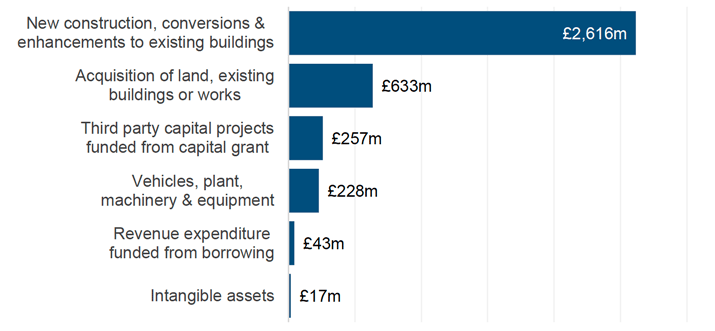
Source: LFR CR
Table 3.1 shows the breakdown of capital expenditure between 2015-16 and 2019-20. New construction, conversions and enhancements to existing building has consistently accounted for the majority of capital expenditure over this period.
| 2015-16 | 2016-17 | 2017-18 | 2018-19 | 2019-20 | |
|---|---|---|---|---|---|
| Acquisition of land, existing buildings or works | 58 | 233 | 363 | 169 | 633 |
| New construction, conversions & enhancements to existing buildings | 2,097 | 2,358 | 2,255 | 2,317 | 2,616 |
| Vehicles, plant, machinery & equipment | 183 | 193 | 185 | 225 | 228 |
| Intangible assets | 6 | 10 | 5 | 5 | 17 |
| Revenue expenditure funded from capital grant and borrowing 2 | 192 | 168 | 177 | 262 | 301 |
| Total Capital Expenditure | 2,535 | 2,962 | 2,984 | 2,977 | 3,794 |
Source: LFR CR for 2019-20 and CR Final for all other years
Notes
1 The 2019-20 figures split by General Fund and HRA are available in tab Chart 3.1 of the 'SLGFS 2019-20 - Publication Tables' Excel file.
2 The 2019-20 figures split by revenue expenditure funded from borrowing and third party capital projects funded from capital grants are available in the 'Chart 3.1' tab of the 'SLGFS 2019-20 - Publication Tables' Excel file. This split is not available for years' prior to 2019-20.
Expenditure on acquisition of land, existing buildings or works has more than tripled between 2018-19 and 2019-20, an increase of £464 million. This increase can be attributed to sale and leaseback transactions by Glasgow City Council in relation to Culture and Related Services. A sale and leaseback transaction is where the owner of an asset sells it to a third party and then leases the same asset back from the new owner. The original owner, in this case Glasgow City Council, will then recognise the leased asset as capital expenditure incurred, whilst also recording income from the capital receipts generated by the sale of the asset. Further information on capital receipts is provided in Chapter 3.2.3.
3.3.1 Capital Expenditure by Service
Chart 3.2 shows capital expenditure in 2019-20 by service. HRA had the largest share of expenditure at £889 million, followed by Education with £749 million.
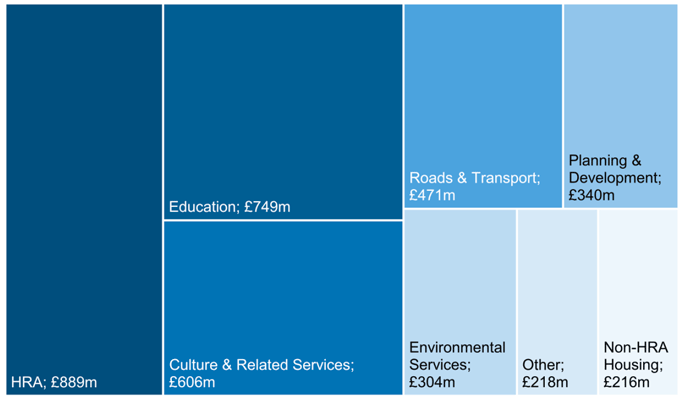
Source: LFR CR
Notes
'Other' includes Social Work, Central Services and Trading Services
Chart 3.3 shows capital expenditure for 2015-16 to 2019-20 for each service that accounts for more than seven per cent of total capital expenditure. Expenditure on both HRA and Environmental services has continued to increase in 2019-20; whilst expenditure on Roads & Transport and Planning & Development has remained stable over the last year.
Culture and Related Services has shown a significant increase in capital expenditure in 2019-20 – as noted in Chapter 3.1, this increase can be attributed to sale and leaseback transactions by Glasgow City Council.
Capital expenditure on Education has started to increase again, following a significant decrease in 2018-19. This likely reflects the end of a programme of capital investment in Education in 2018-19, with new investment starting in 2019-20.
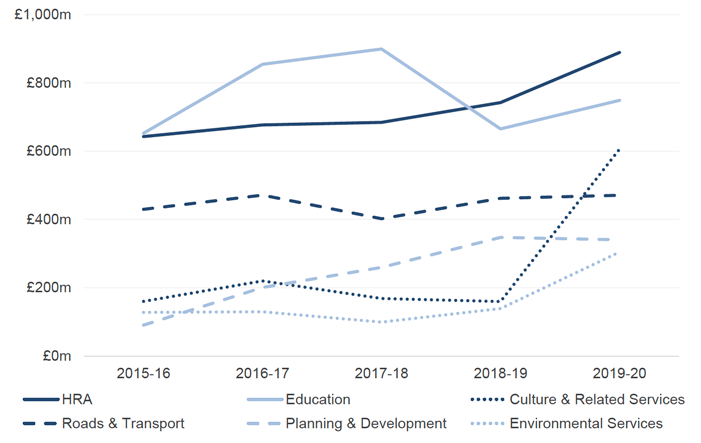
Source: LFR CR for 2019-20 and CR Final for all other years
Notes:
1 This chart excludes expenditure relating to Social Work, Non-HRA Housing, Trading Services and Other Services as they each make up less than seven per cent of the total capital expenditure in 2019-20. Figures for these services are available in the 'Chart 3.3' tab of the 'SLGFS 2019-20 - Publication Tables' Excel file.
3.1.2 General Fund Capital Expenditure by Council
In any given year, capital expenditure per person varies substantially between local authority areas. This will in part reflect the different priorities of local authorities, however it also reflects differences in the timing of capital projects. Expenditure on capital projects can be highly variable as some projects can be high-value and infrequent, and expenditure per head in local authority areas will move, possibly substantially, from year to year as projects begin or wind down.
Chart 3.4 shows capital expenditure on General Fund services per person by council. In 2019-20, the average capital expenditure per person across all councils was £525, an increase from £400 per person in 2018-19. Spend per person ranged from £193 per person in South Lanarkshire to £1,363 per person in Shetland.
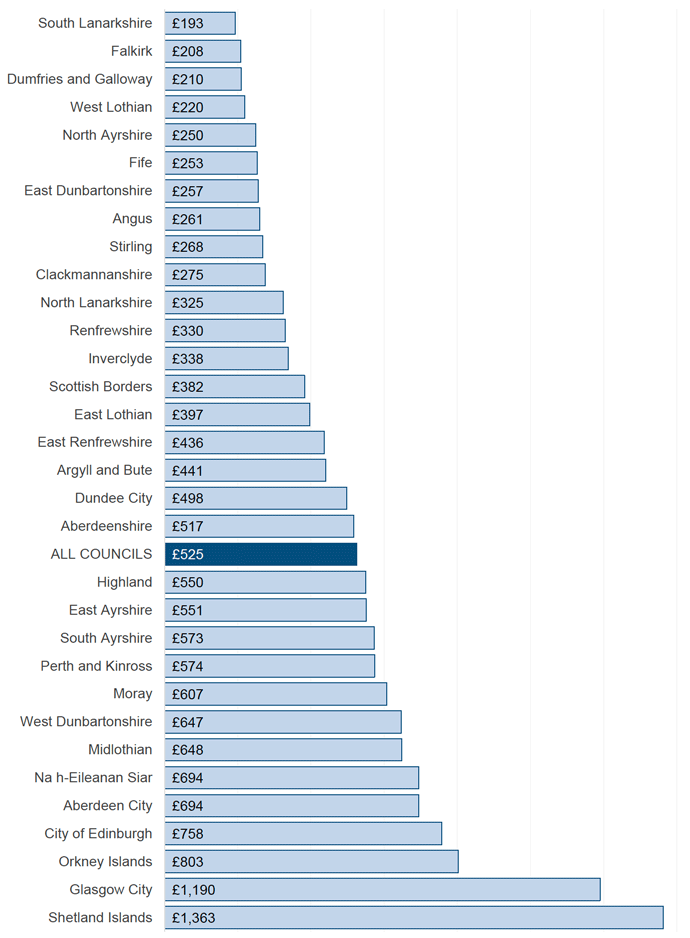
Source: LFR CR, Mid-Year Population Estimates
3.2 Capital Financing
Chart 3.5 shows how local authorities financed their capital expenditure in 2019-20. The two main sources of financing were grants & contributions, £1,297 million, and borrowing from the Loans Fund, £1,128 million, which together accounted for almost two-thirds of all capital financing (63.9 per cent) in 2019-20.
Capital grants are grants provided to local authorities to fund capital investment. Capital grants from the Scottish Government[15] are the main component of grants & contributions, making up almost three-quarters of grants & contributions (73.7 per cent, or £956 million) in 2019-20. This category also includes capital grants received from the UK Government; other government agencies and Non-Departmental Public Bodies (NDPBs); other local authorities; and private developers.
More information on borrowing is provided in Chapter 3.2.1.
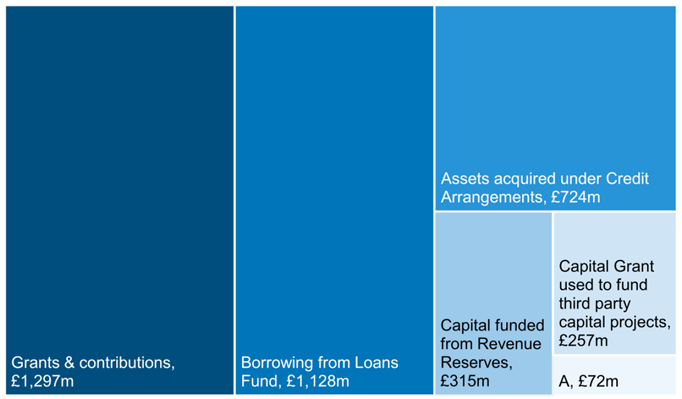
Source: LFR CR
Notes:
A = Capital Fund & Capital Receipts
1 'Borrowing from Loans Fund' includes borrowing used to fund grants to third party capital projects. This, along with 'Capital Grant used to fund third party capital projects' will also be counted under revenue income.
Chart 3.6 shows capital financing by type from 2015-16 to 2019-20. Grants & contributions and borrowing have consistently been the main sources of capital financing across this period. The fluctuations in borrowing reflect the nature of capital and can be influenced by the type of expenditure being undertaken in each year.
Changes in grants & contributions over this period have largely been driven by changes in capital grants from the Scottish Government. In particular, reallocation of capital funding payments from one financial year to another, as agreed between the Scottish Government and COSLA[16], has impacted the following figures:
- an additional £94.2 million included in 2015-16, reallocated from 2013-14;
- the 2016-17 figure excludes £150 million that has been reallocated and included in the 2019-20 capital settlement.
Financing from assets acquired under credit arrangements has shown a significant increase in 2019-20 – as noted in Chapter 3.1, this can be attributed to sale and leaseback transactions for Culture and Related Services by Glasgow City Council.
Use of Capital Fund and Capital Receipts to finance capital expenditure has continued to decrease in 2019-20; whilst the use of capital grants to fund third party capital projects has continued to increase. Capital funded from revenue reserves has remained stable over this period.
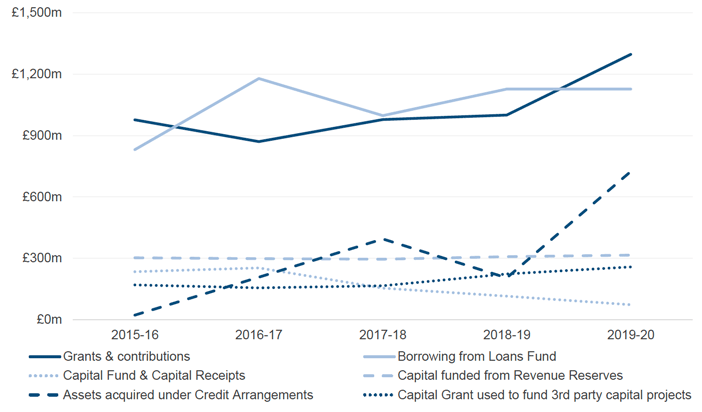
Source: LFR CR for 2019-20 and CR Final for all other years
Notes
1 'Borrowing from Loans Fund' includes borrowing used to fund grants to third party capital projects. This, along with 'Capital Grant used to fund third party capital projects' will also be counted under revenue income.
3.2.1 Borrowing and Credit Arrangements
Local authorities can borrow to fund capital expenditure, either through the borrowing of money or by way of a credit arrangement, such as a lease. The cost of repaying debt, including the interest costs, is expenditure to the revenue accounts. The costs of servicing debt in 2019-20 are provided in Table 2.5, which shows the cost of repayments and interest payable.
The Local Government (Scotland) Act 1973 provides councils with a general power to borrow money. Other local authorities' powers are set out in legislation specific to that authority. The Local Authority (Capital Finance and Accounting) (Scotland) Regulations 2016 sets out the purposes for which a local authority may borrow.
Table 3.2 provides a summary of borrowing and credit arrangements in 2019-20. Local authorities determined they would fund £1,128 million of capital expenditure from borrowing in 2019-20, this is consistent with the amount of borrowing local authorities used to fund capital expenditure in 2018-19.
In 2019-20, local authorities also entered into credit arrangements, recognising debt of £724 million, an increase of £520 million from 2018-19. This increase can be attributed to sale and leaseback transactions for Culture and Related Services by Glasgow City Council, as noted in Chapter 3.1.
| General Fund 2 | HRA | Total | |
|---|---|---|---|
| Advances for Capital Expenditure 3 | 639 | 460 | 1,100 |
| Advances for Consented Borrowing | 28 | - | 28 |
| Total Loans Fund Borrowing | 667 | 460 | 1,128 |
| Credit Arrangements | 724 | - | 724 |
| Total Borrowing and Credit Arrangements | 1,391 | 460 | 1,852 |
Source: LFR CR
Notes
1 Figures for 2015-16 to 2019-20 are available in Table 3.2a in the 'SLGFS 2019-20 - Publication Tables' Excel file.
2 General Fund figures include amounts relating to Harbour Accounts for Orkney and Shetland.
3 Advances for Capital Expenditure includes borrowing from the loans fund used to fund grants to third party capital projects. Local authorities will also have included this within their revenue figures.
Trends for borrowing from the Loans Fund and credit arrangements between 2015-16 and 2019-20 are shown in Chart 3.6 and discussed in Chapter 3.2.
3.3 Capital Receipts
Capital receipts is the term used to recognise income from the sale or disposal of an asset, such as land or council housing. Capital receipts may only be used to fund capital expenditure or for a purpose specified by statute, or statutory guidance.
Local authorities can also hold capital receipts in a capital reserve for future use. This means the value of capital receipts received in year may not equal the amount used in year. Table 3.3 provides a summary of capital receipts for 2019-20.
| General Fund 2 | HRA | Total | |
|---|---|---|---|
| Capital Receipts made available for use in year | |||
| Capital Receipts from the sale / disposal of fixed assets | 536,679 | 4,717 | 541,396 |
| Less: Capital Receipts set aside in the Capital Grants and Receipts Unapplied Account | 4,849 | 140 | 4,989 |
| Add: Transfer of excess capital receipts to the Capital Fund / Capital Receipts Reserve | - | 1,081 | 1,081 |
| Total capital receipts made available for use in year | 531,830 | 5,658 | 537,488 |
| Capital Receipts used in year to… | |||
| Fund capital expenditure | 37,869 | 5,186 | 43,055 |
| Repay debt | 505,828 | 655 | 506,483 |
| Fund premiums incurred on refinancing | - | - | - |
| Fund deferred premiums | 497 | - | 497 |
| Fund equal pay settlements | - | - | - |
| Fund transformation projects | 1,388 | - | 1,388 |
| Total capital receipts used in year | 545,582 | 5,841 | 551,423 |
Source: LFR CR
Notes
1 A breakdown of capital receipts held at 31 March from 2015-16 to 2019-20 by service is available in Table 3.3a in the 'SLGFS 2019-20 - Publication Tables' Excel file.
2 General Fund figures include amounts relating to Harbour Accounts for Orkney and Shetland.
In 2019-20, local authorities generated £541 million in capital receipts. This was an increase of £430 million compared to the capital receipts generated in 2018-19, however, as noted in Chapter 3.1, this increase can be attributed to sale and leaseback transactions for Culture and Related Services by Glasgow City Council. After accounting for any movements of capital receipts between reserves in year, local authorities had £537 million capital receipts available for use in 2019-20.
Local authorities used a total of £551 million capital receipts in 2019-20. The majority of these (92 per cent) were used to fund the repayment of debt – in particular, this figure includes the use of the capital receipts that Glasgow City Council generated through their sale and leaseback transactions. Local authorities used capital receipts to fund £43 million of capital expenditure in 2019-20.
Contact
Email: lgfstats@gov.scot
There is a problem
Thanks for your feedback